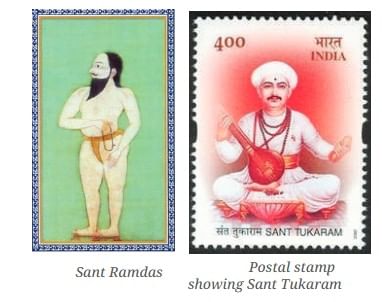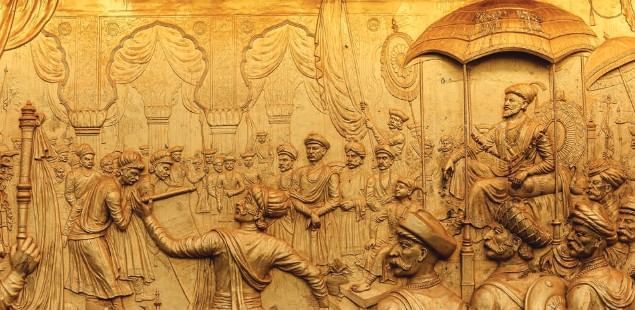Short and Long Answer Questions: The Rise of the Marathas | Social Studies (SST) Class 8 PDF Download
Short Answer Type Questions
Q1. Who were the Marathas, and how did the Bhakti movement contribute to their unity?
Ans: The Marathas were people from the Deccan plateau, primarily Maharashtra, who spoke Marathi, a language rich in literature. The Bhakti movement (7th–17th centuries), led by saints like Dnyaneshwar, Namdev, Tukaram, and Ramdas, fostered unity through devotional Marathi poetry and translations of texts like the Bhagavad Gita. These teachings of equality and faith strengthened Maratha cultural identity, inspiring their rise under Shivaji.

Q2. How did forts help strengthen Maratha power?
Ans: Forts were crucial to Maratha power, controlling trade routes, storing supplies, sheltering armies, and serving as bases for guerrilla warfare. Shivaji captured neglected forts in Pune, using them to establish Swarajya. The Adnyapatra by Ramachandrapant Amatya emphasized forts as the state’s foundation, enabling resistance against Mughal forces, like Aurangzeb, for decades.
Q3. What happened during Shivaji’s meeting with Afzal Khan at Pratapgad in 1659?
Ans: In 1659, Bijapur’s general Afzal Khan attempted to defeat Shivaji through treachery at Pratapgad Fort. Shivaji, equipped with hidden armor and a wāgh nakh (tiger’s claw), killed Khan during the attack. Maratha forces then used guerrilla tactics to defeat Khan’s army in the forest, boosting Shivaji’s reputation and strengthening Maratha rule.
Q4. Why is Shivaji’s raid on Shaista Khan considered remarkable?
Ans: In 1663, Shivaji led a daring night raid on Mughal general Shaista Khan’s camp in Pune with a small force. He attacked Khan, injuring him and forcing him to flee. This bold guerrilla strike stunned the Mughals, boosted Maratha morale, and cemented Shivaji’s fame as a skilled and fearless leader.
Q5. Describe the importance of Shivaji’s raids on Surat.
Ans: Shivaji’s raids on the Mughal port city of Surat yielded wealth worth nearly one crore rupees, funding Maratha armies. He spared religious sites and kind residents, like Mohandas Parekh, earning global recognition in reports like the London Gazette. These raids showcased Shivaji’s strategic brilliance and moral conduct.
Q6. What challenges did the Marathas face immediately after Shivaji’s death?
Ans: After Shivaji’s death in 1680, Sambhaji became Chhatrapati but was captured and executed by Aurangzeb. Raigad fell, and Rajaram fled to Gingee, shifting the war south. Tarabai led invasions into Mughal territories, using guerrilla warfare to resist Mughal control, ensuring Maratha survival.
Q7. What role did Peshwa Bajirao I play in expanding Maratha power?
Ans: Peshwa Bajirao I expanded Maratha influence beyond the Deccan, capturing Lahore, Attock, and Peshawar through brilliant cavalry-led campaigns. His leadership made the Marathas a pan-Indian power, laying the foundation for their dominance despite later setbacks like the Third Battle of Panipat in 1761.
 A court scene with Shivaji on his throne
A court scene with Shivaji on his throne
Long Answer Type Questions
Q8. Describe the key features of Shivaji’s civilian administration.
Ans: Shivaji’s administration was systematic and people-centric:
Eliminated hereditary offices and land grants, paying officials directly from the treasury to prevent corruption.
Frequent transfers of officials ensured loyalty and reduced rebellion risks.
Supported soldiers’ families with pensions for widows and jobs for sons.
Ashta Pradhana Mandala, a council of eight ministers, managed operations efficiently. These measures ensured discipline, fairness, and centralized authority in the Maratha Empire.
Q9. What were the main features of Maratha naval power under Kanhoji Angre?
Ans: Kanhoji Angre, the Maratha navy chief in the 18th century, used the Konkan coast’s geography to defeat European powers despite inferior ships. The Marathas challenged European trade pass systems by demanding passes in return, frustrating the British and Portuguese. Kanhoji’s navy symbolized indigenous resistance to foreign naval dominance.
Q10. Explain the cultural contributions of Ahilyabai Holkar.
Ans: Ahilyabai Holkar, an 18th-century ruler, governed central India with compassion. She rebuilt major temples like Kashi Vishwanath and Somnath, revived the Maheshwar handloom tradition, and supported artisans. Her welfare projects and infrastructure development enhanced spirituality, culture, and prosperity, leaving a lasting legacy.
Q11. Describe Shivaji’s strategies and achievements in building the Maratha power.
Ans: Shivaji Bhonsle (1630–1680) founded Swarajya through innovative strategies:
Early life & strategies: Captured Pune forts at 16 using guerrilla warfare.
Military campaigns: Killed Afzal Khan (1659), raided Shaista Khan’s camp (1663), and looted Surat twice for resources.
Navy and forts: Built a navy to protect the coast and used forts for defense.
Coronation (1674): Crowned Chhatrapati at Raigad with Vedic rites.
Legacy: Expanded into Tamil Nadu and Karnataka, rejected slavery, and inspired Indian rulers with his vision and administrative genius.
Q12. How did the Marathas resist and expand after Shivaji’s death?
Ans: After Shivaji’s death in 1680, the Marathas resisted Mughal pressure:
Sambhaji: Executed by Aurangzeb after capture.
Rajaram: Fled to Gingee, extending conflict to the south.
Tarabai: Led invasions into Mughal territories, preserving independence.
Peshwa leadership: Bajirao I captured Lahore, Attock, and Peshawar, making Marathas a pan-Indian power.
Revival: Recovered after Panipat (1761) under Madhavrao I, with Mahadji Shinde recapturing Delhi in 1771. Their resilience ensured Maratha dominance.
Q13. Explain the main features of Maratha administration under Shivaji.
Ans: Shivaji’s administration ensured stability and fairness:
Civilian administration: Removed hereditary posts and jagirs, paid salaries from the treasury, and transferred officials to prevent corruption. Supported soldiers’ families with pensions and jobs. Used Ashta Pradhana Mandala for governance.
Revenue system: Collected chauth (25%) and sardeshmukhi (10%) from protected areas.
Military organization: Included infantry, cavalry (bargirs and shiledars), and navy, with forts as defensive bases per the Adnyapatra.
Judicial system: Panchayats handled local justice, with appeals to chiefs and kotwals maintaining order.
Trade and navy: Promoted trade and challenged European naval dominance. This system ensured a strong, people-centered empire.
Q14. Discuss the cultural revival initiated by Shivaji and continued by his successors.
Ans: Shivaji’s Swarajya sparked a cultural awakening:
Shivaji’s contributions: Used Sanskrit inscriptions on his seal, commissioned the Rajya-Vyavahara-Kosha for Marathi and Sanskrit administration, rebuilt temples, and respected all religions.
Maratha women: Tarabai led invasions, while Ahilyabai Holkar rebuilt temples and revived handlooms.
Southern Marathas: Serfoji II of Thanjavur enriched Carnatic music, supported Bharatanatyam, and established India’s first native printing press and Dhanwantari Mahal.
Other regions: Bhonsles of Nagpur revived Jagannath worship at Puri. These efforts promoted arts, spirituality, and cultural pride across India.
Q15. Why are the Marathas considered the last great Indian power before British rule?
Ans: The Marathas were the last major Indian empire due to:
Political power: Expanded to Lahore, Attock, and Peshawar under Bajirao I; recaptured Delhi in 1771 under Mahadji Shinde.
Administration: Shivaji’s forts, Ashta Pradhan, fair justice, and trade networks ensured efficient governance.
Military strength: Strong cavalry, artillery, and navy under Kanhoji Angre challenged Europeans.
Cultural contributions: Promoted Marathi, Sanskrit, temples, and arts.
Decline: Internal divisions and losses in the Anglo-Maratha Wars (1775–1818) led to British dominance. The Marathas’ resistance to Mughals and British made them India’s last great indigenous power.
|
69 videos|431 docs|46 tests
|
FAQs on Short and Long Answer Questions: The Rise of the Marathas - Social Studies (SST) Class 8
| 1. What were the key factors that contributed to the rise of the Marathas? |  |
| 2. Who was Shivaji Maharaj and what role did he play in the Maratha Empire? |  |
| 3. How did the Maratha Empire manage to expand its territory during its peak? |  |
| 4. What were the administrative innovations introduced by the Marathas? |  |
| 5. What was the impact of the Maratha Empire on Indian history and society? |  |
















